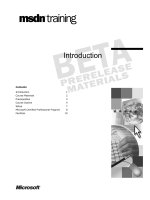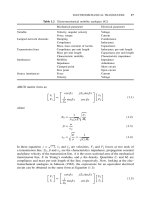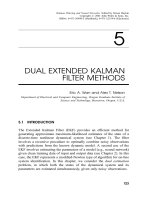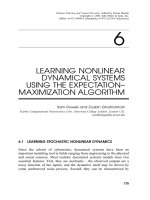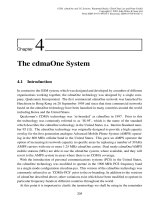Tài liệu ORGANIC CHEMICALS AND POLYMERS pdf
Bạn đang xem bản rút gọn của tài liệu. Xem và tải ngay bản đầy đủ của tài liệu tại đây (463.25 KB, 24 trang )
1
Organic chemicals and polymers
A company
of ThyssenKrupp
Technologies
Uhde
ThyssenKrupp
2
Table of contents
1. Company profile 3
2. Uhde's fields of activity 4
3. Organic chemicals
3.1 Ethylene dichloride EDC, Vinyl chloride VCM 6
3.2 Ethylene oxide EO, Ethylene glycol MEG 8
3.3 Propylene oxide and other organic chemicals 10
4. Polymers
4.1 High-density polyethylene HDPE 12
4.2 Low-density polyethylene LDPE 14
4.3 Polypropylene PP 16
4.4 Suspension polyvinyl chloride PVC-S 18
4.5 Polyester PET 20
4.6 Polyamide and special polymers 22
Page
Organic chemicals and polymers
Plastics have become an indispensable material
in everyday life and are used in a wide variety
of technical applications. Over 200 million
tonnes of plastics are produced throughout
the world every year, most of which are
commodity polymers such as polyethylene,
polypropylene, polyvinyl chloride and polyester.
When it comes to the production of these plastics
Uhde provides its customers with large-scale,
cost-effective, environment-friendly plants
based on first-class processes.
3
1. Company profile
With its highly specialised workforce
of more than 4,900 employees and its
international network of subsidiaries and
branch offices, Uhde, a Dortmund-based
engineering contractor, has, to date, suc-
cessfully completed over 2,000 projects
throughout the world.
Uhde’s international reputation has
been built on the successful application
of its motto
Engineering with ideas to
yield cost-effective high-tech solutions
for its customers. The ever-increasing
demands placed upon process and
application technology in the fields of
chemical processing, energy and envir-
onmental protection are met through a
combination of specialist know-how,
comprehensive service packages, top-
quality engineering and impeccable
punctuality.
Overview
In the world of international plant con-
struction, companies have to be able to
provide industrial plant owners with first-
class processes which guarantee the
maximum level of productivity, availabil-
ity, economic viability and environmental
compatibility.
For decades now, Uhde has been a
leading force in the construction of
plants for organic chemicals and poly-
mers. Supported by licensors of inter-
national acclaim, such as LyondellBasell,
Evonik, Shell and Vinnolit, we are able to
provide our customers with premium
processes in a variety of fields.
By working closely with these licensors,
we are among the market leaders in
various fields of activity, such as EDC/VCM
and polyethylene, with respect to the
overall annual capacity of the plants we
have so far built.
The following pages provide an overview
of the main fields in which we are active.
Uhde’s head office
in Dortmund, Germany
Natural gas
Crude oil
Coal
Sodium
chloride
Reformate
Coke
oven
light oil
Pyrolysis
gasoline
Refinery
Steam cracker
Propane
Butanes
Aromatics
separation
Coke plant
Electrolysis
Synthesis gas
generation
Crops (Starch)
4
Uhde's fields of activity
Organic chemicals, polymers and more
2.
With its wide range of first-class proprietary
technologies and those supplied by reput-
able licensors, Uhde is active in an exten-
sive number of different chemical and
petrochemical segments.
Organic chemicals
Ethylene dichloride (EDC)
Vinyl chloride (VCM)
Ethylene oxide (EO)
Ethylene glycol (MEG)
Propylene oxide (PO)
Vinyl acetate (VAM)
Oxo alcohols
Formaldehyde
UIF
Organic chemicals Uhde can offer plants in a wide range of fields, such as:
UIF
These technologies are supplied by
our subsidiary Uhde Inventa-Fischer
Adhesives
Textile fibres, filaments,
technical yarns, films,
engineering plastics
Plasticisers, solvents
Mouldings,
films, fibres
Pipes, profiles
Textile fibres, filaments,
films, bottles,
techn. applications
EPS: Insulating foam,
packaging
Ethylene
Propylene
Benzene
Xylenes
Chlorine
Caustic soda
Hydrogen
Styrene
Caprolactam
Cyclohexane
Adipic acid
Terephthalic acid/DMT
Phthalic anhydride
Vinyl chloride
Ethylene glycol
Ethylene oxide
p-Xylene
o-Xylene
Ethylene
dichloride
Polyethylene
Polypropylene
Oxo products
Polystyrene
Polyamide 6
Polyester (PET)
Polyvinyl chloride
Methanol
m-Xylene
Isophthalic acid
Formaldehyde
Urea-Formaldehyde
ABS
Mouldings
Foam materials
Polyurethane
Acrylonitrile
Propylene oxide
Polybutadiene
Polyamide 6.6
Butadiene
Lactic acid
Polylactide
Glucose
Fibres, films, bottles,
medical applications
5
Polymers Other chemical fields
Polymers
Polypropylene
Homopolymers
Copolymers
Polyethylene
High-density polyethylene (HDPE)
Medium-density polyethylene (MDPE)
Low-density polyethylene (LDPE)
Linear polyethylene (LLDPE)
Polyvinyl chloride
PVC-S
Polyester
UIF
PET, PBT, PEN, PTT and copolyester
for textile, bottle and film grade
Polyamide
UIF
PA 6, 6.6, 11, 12 and
copolyamide for textile applications
and engineering plastics
Polylactide (PLA)
UIF
Others
Styrenic plastics
(ABS, EPS, GPPS/HIPS)
Carboxymethylcellulose (CMC)
Urea-formaldehyde resins
UIF
Engineering plastics
UIF
These technologies are supplied by
our subsidiary Uhde Inventa-Fischer
6
Ethylene
Chlorine
Direct
chlorination
Vinyl chloride VCM
recycle EDC
chlorination
EDC
distillation
Oxychlorination
HCl
by-product
recovery
HCl
Oxygen
liquid + gaseous
by-products
EDC
cracking
EDC
VCM
distillation
EDC
Vinyl chloride, its precursor ethylene dichloride,
and also polyvinyl chloride, the main end prod-
uct, rank amongst the world’s largest money-
spinners. 35-50 million tonnes of each product
are produced around the world each year. And,
although people have been saying for decades
that chlorine chemicals are on their way out,
production continues to grow by 3-4 % per year.
This is due on the one hand to the versatility of
PVC, and on the other, to the considerable im-
provements which the processes have undergone
in the last years with regard to environmental
and safety issues.
Uhde is the exclusive contractor for Vinnolit tech-
nology. Vinnolit has been producing EDC, VCM
and PVC for over 60 years and is one of the 10
largest PVC producers in the world. Since 1963
we have used Vinnolit know-how to design new
plants for our customers and optimise existing
ones. The overall annual capacity of all these
plants has reached more than 10 million tonnes
of EDC and more than 5.5 million tonnes of VCM.
Uhde has engineered and constructed several
large vinyl complexes with integrated chlor-alkali
electrolysis plants. A new huge vinyl complex
is being built by Uhde on the Persian Gulf.
It includes the entire process chain from the
chlor-alkali electrolysis and the EDC/VCM plants
to the PVC plant. The annual capacities of the
individual plants within the framework of this
project will combine to form one of the world's
largest PVC complexes.
Our extensive experience in the design, con-
struction and commissioning of such plants and
our intensive development of individual process
steps and equipment are borne out by the above
successes. Our joint research and development
projects with Vinnolit ensure that we supply
competitive, environment-friendly processes
which produce high-quality products.
The latest joint development is the new boiling
reactor technology for the direct chlorination of
ethylene. This new technology provides an
energy-efficient technology for the production of
furnace feed and sales EDC from chlorine and
ethylene without the need for a distillation step.
In combination with a special catalyst, by-prod-
uct formation is significantly minimised. The first
production-scale plant (capacity 250,000 t/year
of EDC) is operating successfully at Limburgse
Vinyl Maatschappij NV (LVM), Tessenderlo,
Belgium.
Ethylene dichloride EDC
Vinyl chloride VCM
We provide technologies with
economic and environmental benefits
Balanced EDC/VCM process
3.1
7
Biggest VCM Plant in China
SINOPEC Qilu Petrochemical Corp.
Linzi, Zibo, Shandong Prov., China
400,000 t/year of VCM (balanced)
3D model of one of the world's
largest PVC complexes
ARVAND Petrochemical Co.,
Bandar Imam, Iran
Capacities of the complex:
570,000 t/year of chlorine
329,000 t/year of sales EDC
343,000 t/year of VCM
340,000 t/year of PVC
Boiling reactor at LVM,
Tessenderlo, Belgium
250,000 t/year of EDC
Ethylene
Oxygen
CO
2
High-purity EO
MEG
DEG
TEG
Water
EG
reaction
EO
reaction
EO
recovery
CO
2
removal
EG
dewatering
EG
purification
MEG = mono ethylene glycol, DEG = di ethylene glycol, TEG = tri ethylene glycol
Light ends
removal &
EO purification
8
EO/EG production process
Ethylene oxide (EO) is one of the chemical
industry’s most versatile products. Its various
derivates – ethylene glycols, glycol ether,
ethoxylates and ethanolamines – are used in
the production of plastics, and in the manufac-
ture of solvents, brake fluids, cosmetics, pro-
pellants, antifreeze etc. An emerging application
is the manufacture of 1,3-propanediol.
In the next few years the ethylene oxide market
is estimated to grow by more than 5% per year.
Mono ethylene glycol is the most important
derivative of ethylene oxide. Its growth is driven
by an increasing demand for polyester, both
bottle-grade and fibre-grade.
Besides low feedstock prices and large capaci-
ties, the application of best available technology
is of key importance. Shell is one of the leading
EO/MEG manufacturers and licensors as well as
the leading supplier of EO catalysts. The quality
of the glycol produced by the Shell process
ranks among the highest in the world and meets
the most stringent specifications for polyester
fibre-grade and bottle-grade PET. Furthermore,
the Shell process is known for its high safety
standards and its low environmental impacts.
For the engineering and construction of EO/MEG
plants, Uhde uses Shell's outstanding EO/MEG
technology and provides plant concepts which
permit economical production. Uhde is one of
Shell’s authorised basic engineering contractors.
Current project capacities range from 100,000
t/year to 600,000 t/year. At the moment a
360,000 t/year MEG is being constructed at
Chengdu, Sichuan Province, China.
Ethylene oxide EO, Ethylene glycol MEG
World-class processes
3.2
9
CNOOC / Shell Nanhai Petrochemical Complex, China
EO/EG plant: 320,000 t/year of mono ethylene glycol
Glicoles Mexicanos, Coatzacoalcos,
200,000 t/year of mono ethylene glycol
Petrochina Sichuan Petrochemical
Company, Chengdu, China
360,000 t/year mono ethylene glycol
Propylene
Hydrogen
peroxide
Propylene recycle
Methanol recycle
PO
Waste water
Reaction
unit
Decompressing/
Propylene recycling
Methanol
processing
PO
purification
New Evonik/Uhde
propylene oxide technology
Propylene oxide
On the basis of an exclusive partnership Evonik
and Uhde have jointly developed an innovative
co-product free and environment-friendly
process for the production of propylene oxide
(PO) from propylene and hydrogen peroxide
(H
2
O
2
) with the aid of a special catalyst. The
process has incorporated years of experience
gained through the operation of a pilot plant
with all relevant process steps. The pilot plant
demonstrated under practical conditions the
absence of co-products as well as the environ-
mental compatibility and high product yield of
the process, thus enabling it to be developed to
market maturity. The Evonik/Uhde HPPO tech-
nology has successfully been in commercial
operation since 2008 and has proven itself in
a plant which is the first of its kind.
Operation is highly cost-effective due to efficient
feedstock consumption, high-performance and
low capital investment. The epoxidation reactor
is specially designed for the exothermic reaction
and combines efficient heat transfer with an
almost ideal plug-flow characteristic. The lower
capital investment compared to other state-of-
the-art PO technologies allows the investor to be
more flexible in his investment decisions. A fur-
ther advantage: We can also provide our STAR
process
®
for the production of propylene feed
via oxydehydrogenation of propane.
Other organic chemicals
For the production of formaldehyde from
methanol Uhde licences two process variants
based on silver and metal oxide catalysts,
respectively, via its subsidiary Uhde Inventa-
Fischer. Formaldehyde is mainly used for the
production of synthetic resins, for instance for
the production of urea-formaldehyde resins,
which are used as adhesives for the production
of plywood and particle board. Process tech-
nology for the production of these resins is also
available from Uhde Inventa-Fischer.
As a process-oriented engineering company
Uhde also offers, on a case-to-case basis,
processes for the production of further organic
chemicals such as oxo alcohols, vinyl acetate
and purified terephthalic acid. We offer these
processes in cooperation with various well-
known producers and licensors.
In order to ensure that we offer customers
the optimum technical and economic solution,
we operate proprietary pilot plants, such as
those for distillation, extraction and extractive
distillation processes. In addition, we are also
equipped with a number of test racks for
testing new catalysts or process schemes.
Propylene oxide and other organic chemicals
Optimum technical and economic solutions
10
3.3
World's first HPPO plant successfully in
commercial operation since 2008
11
Propylene oxide pilot plant
12
Uhde’s experience in the design of HDPE plants
stretches as far back as the 1950s. The first
plant was constructed in 1959, and by 2005
Uhde had already carried out the engineering
for more than 30 plants around the world
based on the Hostalen
®
process. The overall
capacity of all the plants constructed amounts
to more than 4 million tonnes per year. Additional
plants with a capacity of 3 million tonnes per
year are under construction.
The HD Hostalen
®
slurry process, originally
developed by Hoechst AG, is now marketed
by LyondellBasell, the largest manufacturer
of polyethylene in Europe.
HDPE products are mainly used in film, pipes,
blow moulding applications, injection moulding
applications, tapes and fibres. And it is here
that bimodal products used primarily in the
manufacture of high-quality pipes and films
are particularly worthy of mention.
LyondellBasell’s HD Hostalen
®
slurry
process for the production of unimodal
and bimodal HDPE
In the past, Uhde engineers have continually
confirmed their expertise in this area by work-
ing with the licensor to incorporate the latest
technological innovations in HDPE technology
into their plants. Their scope of services covers
every aspect of plant design, from basic
engineering to detail engineering. And whilst
the first plant designed by Uhde had a capacity
of only 6,000 tonnes per year, today’s plants
now achieve capacities of 400,000 tonnes per
year.
The list of polyolefin plants designed by Uhde
in the last few years is impressive and includes
some of the world's largest HDPE plants:
• 2 HDPE plants, each 300,000 t/year,
commissioning 2006
• 300,000 t/year MD/HDPE plant,
commissioning 2006
• 300,000 t/year HDPE plant,
commissioning 2007
• 220,000 t/year HDPE plant,
commissioning 2008
Uhde has taken on a large part of the EPCC
services (engineering, procurement, construc-
tion and commissioning) for these contracts
up to and including the turnkey supply of the
plants.
High-density polyethylene HDPE
A wealth of practical experience
Catalyst
preparation
Catalyst
compounds
Polymeri-
sation
reactor
Receiver
Hexane
Hydrogen
Hexane
Ethylene +
Comonomers
Polymerisation Hexane
separation
and drying
Decanter
centrifuge
Pellet
homogeniser
Dryer
Stabilisers
Extruder
Pelletising Homogenisation/
Dispatch
4.1
13
300,000 t/year HDPE plant
Marun Petrochemical Co., Bandar Imam, Iran
250,000 t/year HDPE plant
SABIC Polyolefine GmbH, Gelsenkirchen
300,000 t/year HDPE plant
Jam Petrochemical Co., Bandar Assaluyeh, Iran
14
LyondellBasell’s LupoTech T
®
process for
the production of a broad range of LDPE
homopolymers and vinyl acetate copoly-
mers
Uhde has been actively involved in the con-
struction of low-density polyethylene plants
since these polymers were first produced on a
commercial scale. The design work carried out
by Uhde's engineers in this field provides proof
of their many years of experience.
In the field of LDPE, Uhde works particularly
closely with LyondellBasell, Europe's largest
manufacturer of polyethylene with an annual
capacity of more than 2.5 million tonnes. To
date, Uhde has designed LDPE plants which
are capable of an overall annual capacity of
approx. 1.5 million tonnes.
Uhde has been highly successful with its LDPE
plants in China. In 2005 not only the world's
largest has been commissioned, which has a
capacity of 400,000 t/year of LDPE, but we
also completed the basic engineering for a
250,000 tonne-per-year plant for Maoming.
Uhde's expertise in working pressures in excess
of 3,000 bar is proof not just of an excellent
process knowledge, but also of exceptional
structural know-how. Moreover, the expertise of
our design engineers is ideally enhanced by the
expertise of our own high-pressure manufac-
turing facilities at our subsidiary Uhde High
Pressure Technologies.
The engineering and construction services
provided by Uhde include all process steps in-
herent in a plant, beginning with the extremely
sensitive reactor system and extending to the
extrusion, drying, storing and packing units.
The polyethylene obtained in the high-pressure
process is predominantly used in the manufac-
ture of films, but is also used for cable sheaths,
blow and injection-moulded parts and pipes.
Low-density polyethylene LDPE
Full engineering service enhanced by our own
high-pressure equipment manufacturing facilities
Compression
Ethylene
LP recycle
gas compressor
Precompressor
HP separator
Final
compressor
Reactor
LP
separator
Melt extruder
Pellet silo
High-pressure (HP)
recycle gas
Low-pressure (LP)
recycle gas
Moderator
Vinyl acetate
Initiator
Polymerisation Pelletising
Dispatch
4.2
15
3D model of one of the world's largest LDPE plants
400,000 t/year of LDPE
High-pressure pipe reactor for LDPE
LDPE plant in China
16
LyondellBasell's Spheripol
®
process for
the production of polypropylene homo-
polymers plus random and heterophasic
copolymers
Polypropylene (PP), first produced commercially
in the 1950s, is one of the fastest growing com-
modity thermoplastics. It is commonly used in
the production of films, fibres and yarns, house-
hold goods, food packaging, bottles, crates,
containers and car parts. Most of the propylene
produced in the world is used for PP manufac-
ture.
Today's polypropylene production technology is
the result of 40 years of continual development.
Uhde started building its first PP plants in the
60s, but the main technological progress was
not achieved until the 80s when important new
catalysts were introduced and reactor design
was optimised. Since then, Uhde has con-
structed plants which produce more than 2.2
million tonnes per year of PP and has managed
to increase plant capacity considerably from
project to project.
Uhde collaborated with Basell in this area for
many years. In 2007 Lyondell and Basell joined
forces combining two major industry players
to create a new global leader. Since then, we
have worked with LyondellBasell on a number
of projects. LyondellBasell's Spheripol
®
process
is the worldwide leading technology for PP
production, and its Spherizone
®
process is THE
new breakthrough process using a multizone
circulating reactor for the production of all types
of polypropylene and novel polyolefins. In 2005
Uhde signed a contract for the basic engineer-
ing of China's biggest single-line polypropylene
plant at Tianjin Petrochemical Company which
comes on-stream in 2009. The plant is based on
LyondellBasell’s Spherizone process. It has a
capacity of 450,000 t/year.
By combining LyondellBasell’s PP technology
with Uhde's STAR process
®
for the dehydro-
genation of propane (PDH) to propylene, the
production costs for polypropylene can be
significantly decreased, because cheap propane
feedstock from natural gas liquids (NGL) or
associated gas can be used.
This process route is becoming more and
more important because there is no equivalent
capacity increase in propylene production from
conventional sources (i.e. steam crackers and
refineries) to meet the increasing demand for
propylene. A propylene demand/supply gap has
been forecasted for the future, leading the way
toward wide application of propylene on-purpose
technologies like PDH.
Uhde can supply tailor-made solutions for the
propane - propylene - PP process chain.
Common utility units (e.g. steam generation
unit, refrigeration unit, cooling tower etc.) can
thus be used, further increasing the feasibility
of such projects.
Polypropylene PP
Proven process gives you the leading edge
Bulk polymerisation Gas phase copolymerisation Steaming
Drying
Catalyst +
cocatalysts
Propylene
recycle
to condenser
Steam Nitrogen
PP powder
Hydrogen
Propylene
Hydrogen
Propylene
Ethylene
4.3
17
350,000 t/year PP, EPPC, Port Said, Egypt
PP Spheripol
®
loop reactors
© LyondellBasell 2002
18
The most widely used process in the manufac-
ture of polyvinyl chloride (PVC) involves suspen-
sion polymerisation. The homopolymers pro-
duced are commonly used in pipes and cables
manufactured using extrusion and moulding
applications. Another extremely widespread use
of PVC-S is the manufacture of sections for win-
dow frames. In addition, PVC-S is also used in
the production of transparent films and in the
manufacture of injection-moulded parts.
Uhde’s experience in the design, engineering
and construction of PVC plants goes as far
back as the 1960s. In designing plants for
PVC-S, Uhde works exclusively with Vinnolit,
one of the 10 largest PVC manufacturers in the
world. Overall, the worldwide capacity of plants
based on the Vinnolit PVC-S process is about
1.8 million tonnes per year.
The Vinnolit PVC-S process uses a high-perform-
ance polymerisation reactor, which is available
in sizes up to 175 m
3
and achieves an annual
productivity of up to 600 t of PVC per m
3
of
reactor volume. Vinnolit's technology does not
require chilled water and can be operated with-
out or in combination with a reflux condenser.
For drying the wet PVC cake Vinnolit has de-
Suspension polyvinyl chloride PVC-S
The entire process chain from Uhde
Cl
2
, EDC, VCM and PVC
Vinnolit's suspension PVC process
includes a high-performance reactor
and a cyclone dryer
Polymerisation Degassing Drying
VCM
Activator
Demin. water
Dispersing agent
Cooling water
Cooling water
High-performance-
reactor
Blowdown
vessel
Pre-degassing
vessel
Steam
Slurry
Degassing
column
to waste water treatment unit
Cyclone drying
system
Centrifuge
PVC
powder to silo
Air
Off-air
Cooling water
veloped a special cyclone dryer, which has been
licensed via Uhde to many PVC producers world-
wide.
The successful execution of numerous projects
can be ascribed to the close partnership between
Vinnolit, as the licensor, and Uhde. Based on
this cooperation Uhde has gained a significant
competitive edge: Uhde is the only engineering
company able to provide customers, from a
single source, with the entire process chain for
a PVC complex, from chlorine manufacture to
EDC/VCM and PVC production.
The world's largest integrated single-train PVC
complex, which includes the complete process
chain as described, is being built by Uhde on the
Persian Gulf for ARVAND Petrochemical Co. The
polymerisation section of this complex is equipped
with 150 m
3
high-performance reactors.
As in all other cases, our cooperation with
Vinnolit is not just aimed at marketing the tech-
nology, but also at continuously developing the
process. Joint development projects comple-
ment the experience gained in production,
research and licensing procedures. Together,
they form a stable basis for continuous opti-
misation of the process.
4.4
19
3D model of one of the world's largest PVC complexes
ARVAND Petrochemical Co., Bandar Imam, Iran
Capacities of the complex:
570,000 t/year of chlorine
329,000 t/year of sales EDC
343,000 t/year of VCM
340,000 t/year of PVC
Inside view of a PVC
high-performance reactor
PVC high-performance reactor
115 m
3
volume
20
Highly efficient production plants are of major
importance in covering the increasing world
demand for high-quality plastic products and
synthetic fibers. As a plant construction con-
tractor and special supplier, Uhde can offer
numerous first-class proprietary processes for
the production of polyesters (PET/PBT/PEN/PTT)
and polyamides (PA 6/PA 6.6) via its subsidiary
Uhde Inventa-Fischer, the leading technology
supplier for these polymers. In total, Uhde
Inventa-Fischer has built more than 400 poly-
ester and polyamide 6 plants worldwide and
ideally enhances Uhde’s technology portfolio.
Polyesters are the feedstock basis for a wide
variety of plastic products, such as fibres and
film as well as bottles and other mouldings.
Polyester plants based on a continuous poly-
condensation process once required up to five
reactors, but Uhde Inventa-Fischer has suc-
ceeded in reducing this number to just two
through technological innovations.
At the same time, the production capacity of
polyester plants has been increased over the
years. Today, Uhde Inventa-Fischer is able to
provide most competitive, high-capacity plants.
The two key technological features of the new
highly economical two-reactor single-stream
technology (2R technology) are the proprietary
ESPREE
®
tower reactor which combines the
esterification and prepolycondensation stages
in a single vessel and the proprietary DISCAGE
®
reactor – a shaftless basket/disk-type reactor
which operates extremely efficiently and ensures
optimum postcondensation despite high viscos-
ity. Uhde Inventa-Fischer can offer a number of
different DISCAGE
®
reactor types. These cover a
broad spectrum of polyester applications for
various final viscosities.
The high molecular polyester product from the
DISCAGE
®
reactor is transferred directly to:
• direct spinning machines (textile-grade
and technical-grade applications) or
• film and sheet casting machines
(film applications, Melt-To-Film MTF
®
)
or it is discharged to the extrusion heads and
converted into chips (pellets).
The latest big step in the polyester technology
is Melt-To-Resin MTR
®
Technology which com-
pletely replaces the conventional solid stating
(SSP) process. Meanwhile, the technology is
in operation in high capacity plants. It is based
upon the well-proven 2-Reactor technology.
Direct production of high-viscosity polyester
melt allows generation of bottle grade resin,
sheet for containers, technical yarns and tyre
cord in a one-step polycondensation process,
thus saving more than 30% of conversion costs
and adding to chips quality.
Polyester PET
Uhde Inventa-Fischer – a partner to rely on
2-reactor Melt-To-Resin MTR
®
process for PET production
Paste mixer Esterfication
and Prepoly-
condensation
ESPREE
®
Polycondensation
DISCAGE
®
reactor
Chip
production
Conditioning
Chips storage
Chip bagging
Chips cutting and
Conditioning
Chips storage
PTA
ADD
PIA
EG
4.5
21
2-reactor plant for textile grade PET
in Belarus which can use both PTA
and DMT as a raw material
2-reactor plant with SSP for
bottle grade PET (Russia)
2-reactor Melt-To-Resin MTR
®
plant in Oman for APET sheet production
22
Polyamide polymers (PA)
Technically mature production plants for poly-
amide 6, known under the brand names Nylon
and Perlon
®
, at the time revolutionised the textile
industry. Now Uhde Inventa-Fischer’s plants
have a leading technological edge throughout
the world. The company’s innovations include
two-stage and also single-stage polymerisation
processes with 100% feedstock yield for the
production of polyamide 6 granules for textile
or technical applications. Uhde Inventa-Fischer
is the only engineering company with the ability
to exploit both polyamide 6 technologies.
Uhde Inventa-Fischer can now build polyamide
6 plants with daily capacities of up to 360 tonnes.
In fact, the company has been responsible for
constructing more than 50% of the world’s total
polyamide 6 production capacity built in the last
five years.
Batch processing of polyamide 6.6/11/12/6.10
and co-polyamides, such as engineering plastics,
moulding compounds and other polymers, can
be carried out in proven autoclave plants with
either discontinuous or continuous drying and
SSP units.
Biodegradable polymer polylactide (PLA)
Polylactic acid or Polylactide – PLA for short – is
a biodegradable polymer based on renewable re-
sources. The feedstock for Uhde Inventa-Fischer’s
PLA process is glucose or sucrose produced
from any starch or sugar containing raw material
such as corn, cereals, cassava, sugar cane or
beet, etc. The feedstock may be sourced locally.
It is expected that PLA will be sourced from
non-food, cellulosic materials in the long term.
The application range of PLA is similar to PET.
It is applied as packaging material (film, sheet,
bottles), textiles (filament, fibers, nonwovens),
and engineering plastics.
The continuous PLA polymerization is the central
part of the PLA process. It is based upon poly-
mer grade L-lactic acid which comes from the
fermentation of glucose to L-lactic acid. The
polymerization of PLA resembles in some respect
other melt-phase processes such as PA 6 and
PET where Uhde Inventa-Fischer has long-term
experience and offers well proven equipment.
Today Uhde Inventa-Fischer is in the position to
license its technology for PLA production plants
with annual capacities of industrial size. With
its mini plant Uhde Inventa-Fischer can perform
customer specific polymer grades development
and sample production.
Polyamide and special polymers
Uhde Inventa-Fischer – a partner to rely on
Uhde Inventa-Fischer’s two-stage
Polyamide 6 process
4.6
Polycondensation Extraction
Extract Water
Regeneration
Drying
23
Kuibyshev Azot’s PA 6 complex in Russia,
producing 215 t/d of Polyamide 6 for all applications
Polylactic acid
Raw materials and products
DSM, Emmen, Netherlands
Polyamide 6 film plant
PDF 23.4.2009
OP 450e

